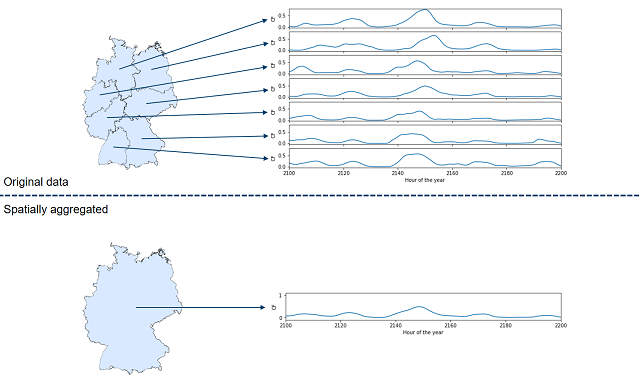Spatial Aggregation
Spatial Aggregation is the aggregation of all data points within a group of ressources over a specific time period (granularity). What does that mean in view of energy systems analysis?
Time series such as wind speeds or solar radiant power as well as attributes of existing components such as demand profiles of households are spatially condensed for example using averaging.
The challenge of spatial aggregation is to maintain the relevant information of all time series within the aggregated regions. These are especially spatial and temporal fluctuations, which play a critical role in the design of grid and storage capacity.
Commonly, regions are mostly aggregated based on electricity grid infrastructure as well as administrative boundaries. For example, points that are well connected by the distribution grid are aggregated to regions. These regions are connected to each other by the transmission grid.
In energy sytem models, these regions are represented by nodes, by averaging all time series within the regions to one time series. In this process, a copperplate (infinite conductivity within the regions) is implicitly assumed.
Consequently, the conductivity within the regions is overestimated due to the copper plate assumption and the fluctuations of the time series are underestimated due to balancing effects.
All in all, the main task of spatial aggregation in METIS consists of developing and applying new methods for the choice of data point groups to be aggregated, such that the critical information loss due to the spatial aggregation is minimized.
 Figure 1. The Illustration of Spatial Aggregation using administrative borders to aggregate data from regional resolution to national resolution. Mind the fluctuations of the regional time series that partly balance out and are not visible any more in the averaged national time series.
Figure 1. The Illustration of Spatial Aggregation using administrative borders to aggregate data from regional resolution to national resolution. Mind the fluctuations of the regional time series that partly balance out and are not visible any more in the averaged national time series.

